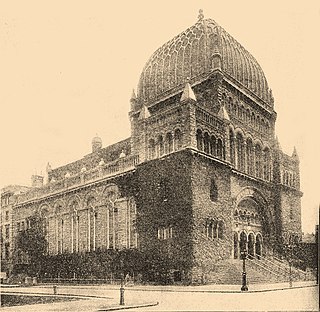
A synagogue, also called a shul or a temple, is a place of worship for Jews and Samaritans. It has a place for prayer where Jews attend religious services or special ceremonies such as weddings, bar and bat mitzvahs, choir performances, and children's plays. They also have rooms for study, social halls, administrative and charitable offices, classrooms for religious and Hebrew studies, and many places to sit and congregate. They often display commemorative, historic, or modern artwork alongside items of Jewish historical significance or history about the synagogue itself.

The Zamość Synagogue, also the Zamość Old Synagogue or the Great Synagogue of Zamość, is a former Jewish congregation and synagogue, located in Zamość, in Lublin Voivodeship, Poland. Completed in 1618 in the Renaissance style, the synagogue is a UNESCO-protected World Heritage Site of Poland. Erected during the times of the Polish–Lithuanian Commonwealth, it functioned as a place of worship for Polish Jews until World War II, when the Nazis turned the interior into a carpenters' workshop. The structure was spared from destruction and in 1992 was listed as a World Heritage Site as part of the Old City of Zamość.

The Szydłów Synagogue is a former Orthodox Jewish congregation and synagogue, that is located at 3 Targowa Street, in Szydłów, in the Świętokrzyskie Voivodeship of Poland. The stone fortress synagogue with heavy buttresses on all sides was completed in 1564 in the Renaissance and Gothic Survival styles.
Ivan Čerešnješ, also known as Ivica Čerešnješ, is a Bosnian architect-researcher at the Center for Jewish Art at the Hebrew University of Jerusalem specializing in the documentation of the Jewish architectural-cultural heritage in the former Yugoslavia and Eastern Europe. During the Bosnian War of 1992–1995 he served as the president of the Jewish community of Bosnia and Herzegovina, and played a central role in the rescue and evacuation of thousands of Sarajevo residents.

The Vilna Shul was an Orthodox Jewish synagogue located at 18 Phillips Street, on the north slope of Beacon Hill, in Boston, Massachusetts, in the United States. The synagogue building was built in 1919 for a congregation by immigrants primarily from Vilna, Lithuania.

The Wilshire Boulevard Temple, known from 1862 to 1933 as Congregation B'nai B'rith, is a Reform Jewish congregation and synagogue at 3663 Wilshire Boulevard, in the Wilshire Center neighborhood of Los Angeles, California, United States. Founded in 1862, it is the oldest Jewish congregation in Los Angeles.

The Sons of Jacob Synagogue, officially Congregation Sons of Jacob, is an Orthodox Jewish congregation and historic synagogue and Jewish museum, located at 24 Douglas Avenue in Providence, Rhode Island, in the United States.

The Angel Orensanz Center is an art and performance space at 172 Norfolk Street, between Stanton Street and East Houston Street, on the Lower East Side of Manhattan in New York City. It was originally built as a synagogue, running through a succession of congregations and continues to be used as one occasionally as The Shul of New York.

Meserich Synagogue, Meserich Shul or Meseritz Shul, also known as Edes Israel Anshei Mesrich, Edath Lei'Isroel Ansche Meseritz or Adas Yisroel Anshe Mezeritz, is an Orthodox Jewish synagogue located at 415 East 6th Street, in the East Village of Manhattan, New York City, New York, United States.
Sidney Eisenshtat was an American architect who was best known for his synagogues and Jewish academic buildings.

The Włodawa Synagogue is a former Orthodox Jewish congregation and synagogue complex, located at 5-7 Czerwonego Krzyża Street, in Włodawa, in the Lublin Voivodeship of Poland. The synagogue complex comprises the Włodawa Great Synagogue, the Small Synagogue or Beit midrash, and a Jewish administrative building, all now preserved as a Jewish museum.

Wooden synagogues are an original style of vernacular synagogue architecture that emerged in the former Polish–Lithuanian Commonwealth. The style developed between the mid-16th and mid-17th centuries, a period of peace and prosperity for the Polish-Lithuanian Jewish community. While many were destroyed during the First and Second World Wars, there are some that survive today in Lithuania.

Historic synagogues include synagogues that date back to ancient times and synagogues that represent the earliest Jewish presence in cities around the world. Some synagogues were destroyed and rebuilt several times on the same site. Others were converted into churches and mosques or used for other purposes.

The Tykocin Synagogue is an historic former Jewish synagogue building, located in Tykocin, Podlaskie Voivodeship, Poland. The synagogue was completed in 1643, in the Mannerist-early Baroque style.

The Sejny Synagogue, also called the White Synagogue in Sejny, is a former Orthodox Jewish congregation and synagogue, located at 41 Piłsudskiego Street, in Sejny, in the Podlaskie Voivodeship of Poland. Designed in the Baroque Revival style and completed in 1885, the former synagogue was desecrated by Nazis during World War II and has been used as a Jewish museum and cultural center since 1987.

The Temple Society of Concord, commonly referred to as Temple Concord, is a Reform Jewish congregation and synagogue located at 450 Kimber Road, in Syracuse, Onondaga County, New York, in the United States.

The Center for Jewish Art (CJA) is a research institute at the Hebrew University of Jerusalem, devoted to the documentation and research of Jewish visual culture. Established in 1979, it documented and researched objects of Jewish art in ca. 800 museums, libraries, private collections and synagogues in about 50 countries. Today, the Center's archives and collections constitute the largest and most comprehensive body of information on Jewish art and material culture in existence. The CJA's research and documentation is included in the Bezalel Narkiss Index of Jewish Art.

Temple Beth-El was a Reform Jewish congregation and synagogue at 945 Fifth Avenue and 76th Street in the Upper East Side of Manhattan in New York City, New York, United States. The synagogue operated between 1891 until c. 1929, and was demolished in 1947. The Temple Beth-El congregation merged with Congregation Emanu-El of New York in 1927.















